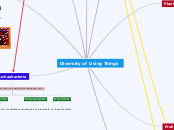によって harjot kaur 8年前.
693
Bio by Hk

によって harjot kaur 8年前.
693

もっと見る
cold environments
extreme salt environments
thrive in high salt concentrations
no oxygen environments
Spirillum
has a twisted shape
Streptococcus
remains in chains after dividing
E. Coli
found in lower intestine of warm blooded organisms
Hexapoda
insects or incecta
Crustacea
branchipoda
Myriapoda
symphyla
pauropoda
diplopoda
millipede
chilopoda
centipede
Chelicerata
Vertebrata
Superclass =
Tetrapods
Mammilia
Mammary glands – produce milk for young -Body hair ( = insulation, camoflague, waterproofing, defense) -Endothermic, four-chambered hearts, highly developed brains -Specialized teeth
lion
Amphibia
-Gas exchange across moist skin -External fertilization in water -Adults live on land, but require moist environment
frog
Urochordata
Cephalochordata
Monkey
monotremes
lay eggs
monotremata
platypus
marsupials
live birth
Diprotodontia
kangaroo
placentals
born from mothers uterus attached to placenta
Magnorder Xenarthra
sloths
developed stinging tentacles
Decompose
Decayed matter
Fungus like
Water moulds
Peronosporales
Slime moulds
Protostelids
Photosynthesis
Sunlight
Plant like
Dinoflagellates
Dinophyceae
Diatoms
Pennate
Green Algea
Marino
Brown Algae
Kelp
Heterotrophs
Feed on other organisms
Animal like
Ciliates
Paramecia
Cilia help swim and capture food
Flagellates
sperms
Flagella-tail like
Sarcodines
Amoeba
Pseudopods
Sporozoans
Glardia
no movement
Angiosperms
Tulips, Dandelions, Oaks
Reproduce through flowers and fruit
Gymnosperms
Pine trees
Reproduce sexually with out water, provides protection, dispersed though various pollination
Seedless Vascular
Ferns, Whisktails
Has roots, stems, leaves, produce spores for reproduction
Bryophytes
Mosses, Liverworts
Tangled, matted growth, no vessels,roots, leaves, stems.
Jelly fungi
clublike-mass of hyphae to absorb water,Cap-produce spores
Mildews,yeast
Saclike structures (ascus), prodce two kind of spores(conidia)
Black Bread Mold
Black spots(sporangia), release spores
Algea
Large pores, produce flagellated spores